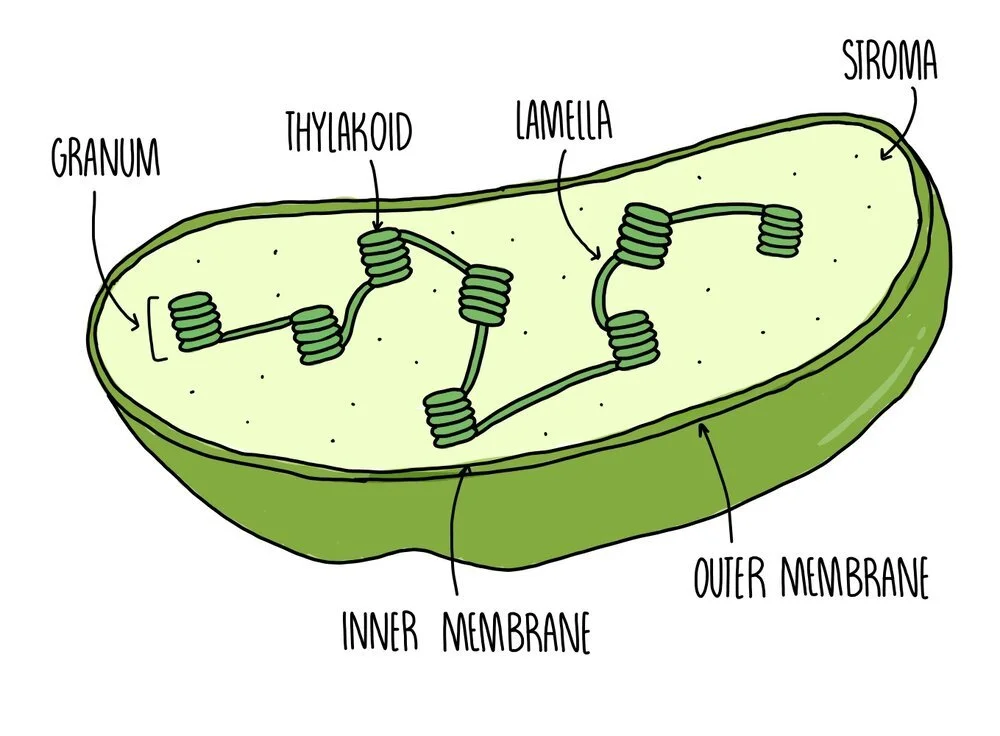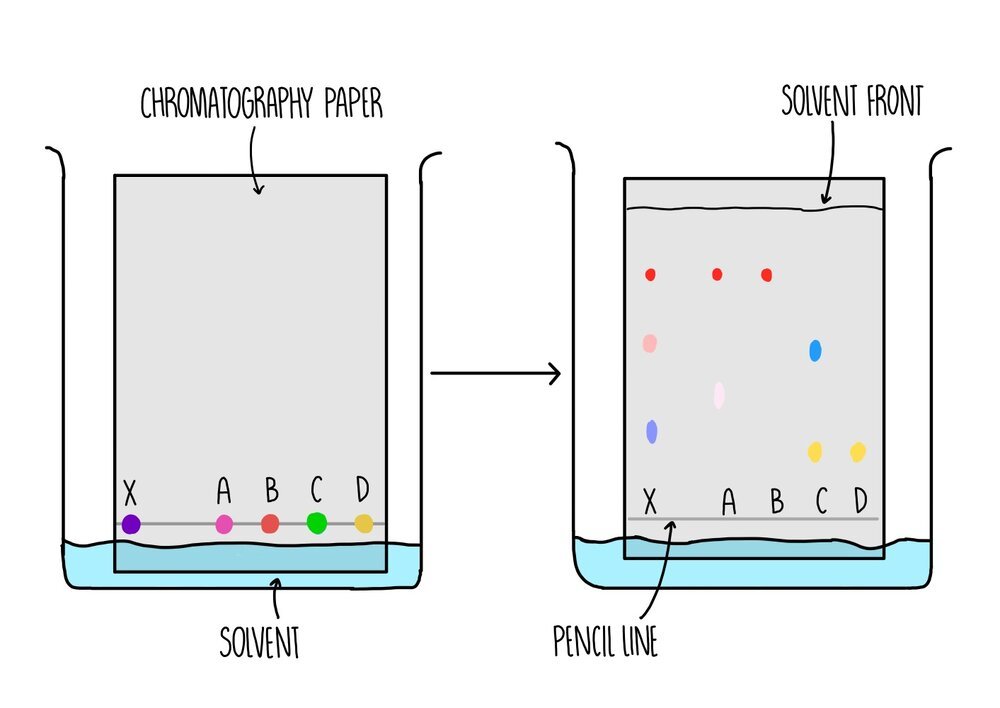Photosynthesis
Photosynthesis reaction
Photosynthesis combines carbon dioxide with water to form glucose and oxygen.
The glucose is used in respiration to produce energy while the oxygen is released from the plant through the stomata. Energy is then used by the plant for processes such as protein synthesis and active transport.
Chloroplast structure
Photosynthesis takes in the chloroplasts of plant cells. Chloroplasts contain fluid-filled sacs called thylakoids. Thylakoids are stacked up like pancakes to form structures which we call grana. Each granum is connected by pieces of thylakoid membrane called lamellae. The gel-like substance which surrounds the thylakoids is called the stroma.
The thylakoids within the chloroplast provide a large surface area to allow as much light to be absorbed as possible. Within the thylakoid membrane are photosystems which consist of pigment molecules attached to proteins. The pigment is what gives plants their colour and includes chlorophyll a, chlorophyll b and carotene. Plants contain two photosystems, called photosystem I and photosystem II. PSI absorbs light at a wavelength of 700 nm while PSII absorbs light at a wavelength of 680 nm.
The overall process of photosynthesis can be split into two stages: the first one stage is known as the light-dependent reaction and (unsurprisingly) requires light to get going. The second is called the light-independent reaction which doesn’t need light but does need the products that were generated in the first stage.
Light-Dependent Reaction (LDR)
The LDR takes place in the thylakoid membranes of the chloroplasts. It takes place in the following stages:
Light energy is absorbed by PSII (even though PSII is involved before PSI, it was discovered afterwards - hence the confusing naming system). Light excites electrons within PSII and causes them to move into a higher energy state. The electrons are passed onto a series of electron carriers within the electron transport chain to PSI.
The electrons which have been lost from PSII need to be replaced. This happens through the photolysis of water - light energy causes a water molecule to split apart and release hydrogen ions, electrons and oxygen. The electrons from water replace the electrons lost from PSII.
As the electrons move along the electron transport chain, they move from high to low energy. The energy lost by the electrons is used to pump hydrogen ions from the stroma into the thylakoids. This generates a proton gradient across the thylakoid membrane.
Protons flow down their concentration gradient through ATP synthase. The energy from the movement of protons is used to phosphorylate ADP to ATP (photophosphorylation) in a process called chemiosmosis.
Light is absorbed by PSI causing another electron to become excited and be passed along the rest of the electron transport chain.
The electron is passed onto NADP to form reduced NADP (NADPH). NADPH is an electron carrier which transfers electrons from one molecule to another.
The ATP and reduced NADP move into the stroma for the next stage of photosynthesis, the light independent reaction.
This process is known as non-cyclic photophosphorylation. There is another process called cyclic photophosphorylation, in which electrons repeatedly cycle through PSI. Electrons leave PSI but instead of being accepted by NADP they flow back down the chain to the first electron acceptor. This means that ATP is produced but no NADPH and may happen when NAPDH is in plentiful supply. Cyclic photophosphorylation is more common in plants with especially high ATP needs and may prevent excess light damaging photosynthetic proteins.
The Light-Independent Reactions (aka the Calvin Cycle)
The Calvin Cycle takes place in the stroma of the chloroplast and uses the products of the LDR (ATP and reduced NADP) to form glucose. The reactions which take place can be divided into three main stages: carbon fixation, reduction and regeneration.
Carbon fixation
Carbon dioxide is ‘fixed’ by adding it to a 5-carbon molecule called ribulose bisphosphate (RuBP), forming a 6-carbon molecule. This reaction is catalysed by an enzyme called Rubisco.
The 6C molecule is unstable and immediately breaks down to form two 3-carbon compounds called glycerate-3-phosphate (GP).
Reduction
An isomerisation reaction occurs which converts GP into a different 3-carbon compound called glyceraldehyde-3-phosphate (GALP). GALP is also known as triose phosphate (TP). This reaction requires energy so ATP (from the light-dependent reaction) is hydrolysed into ADP.
This reaction also requires electrons from the electron carrier reduced NADP (also from the LDR). Reduced NADP transfers electrons to GP, reducing it to GALP.
Some GALP is converted into organic molecules, such as glucose, but some will be used to regenerate RuBP. For every 6 molecules of GALP, 1 is used to produce organic molecules whereas 5 will be used for RuBP regeneration. This means that the Calvin Cycle needs to turn six times to make one hexose sugar.
Regeneration
· GALP is converted back into RuBP - this process requires energy which is generated by ATP hydrolysis.
The cycle is completed and another round of carbon fixation can take place.
Synthesis of organic substances
GP and GALP (aka TP) are used to make all of the biological molecules that a plant needs to grow:
Glucose is made by joining two GALP molecules together. The glucose can then be used to build polysaccharides like starch and cellulose.
Amino acids are made from GP.
Glycerol is made from GALP and fatty acids are made from GP. Glycerol and fatty acids are joined by ester bonds to form triglycerides.
Investigating leaf pigments using chromatography
Leaves of a plant may contain several types of photosynthetic pigment, each of which absorbs light at a specific wavelength. Other, non-photosynthetic pigments may be present and perform functions such as protecting the plant from UV radiation. You can investigate which pigments are present using thin-layer chromatography:
Extract pigment from the leaves of a plant – grind up the leaves with anhydrous sodium sulfate then add a few drops of propanone.
Transfer to a test tube and shake with petroleum ether. You should get two separate layers – the top layer contains the pigments. Transfer this top layer into a test tube containing anhydrous sodium sulfate.
Place drops of extract on a pencil line drawn along the bottom of the TLC plate. This is the stationary phase, made of glass containing a thin layer of silica gel.
The TLC plate is placed in a tank containing a solvent (the mobile phase). You can use a mixture of propanone, cyclohexane and petroleum ether as the solvent.
Place a lid on the tank.
As the solvent moves upwards through the gel, the pigments dissolve in the solvent and are carried up with it.
The more soluble the pigment, the further it will travel up the stationary phase. Since different pigments have different solubilities, they separate out. Draw a line at the point on the TLC plate where the solvent has reached – this is the solvent front.
You can identify each pigment by calculating the Rf value and looking it up in a database.
Optimum conditions for photosynthesis
Light
High light intensity means that the light-dependent reaction can work faster. So the more light, the more photosynthesis.
But it needs to be the right wavelength – in the red or blue part of the spectrum (chlorophyll reflects any light in the green part of the visible spectrum).
Gardeners grow plants in transparent greenhouses or polytunnels which let in light. They may also use lamps to provide light at night.
Temperature
- Temperatures around 25oC allow photosynthetic enzymes to work quickly. At lower temperatures, enzymes become inactive and at higher temperature they can denature.
- At high temperatures, the stomata will also close to conserve water. This stops gas exchange and reduces the rate of photosynthesis.
- Greenhouses trap heat energy from sunlight. Fancier greenhouses will have heaters, cooling systems and air circulation systems to ensure an optimum temperature is maintained year-round.
Carbon dioxide concentration
Atmospheric carbon dioxide concentration is around 0.04%. Concentrations ten times higher (0.4%) can maximise photosynthesis.
Concentrations above 0.4% can cause stomatal closure and a reduction in photosynthesis.
Gardeners can add carbon dioxide to the greenhouse by burning propane.
Limiting factors
The rate of photosynthesis depends on the same three factors outlined above.
Temperature – in general, the higher the temperature the faster the rate of photosynthesis because the enzymes (e.g. Rubisco) and reacting molecules have more kinetic energy so they collide into each other more frequently. If the temperature becomes too high, the rate of photosynthesis decreases because the enzymes involved in photosynthesis are denatured.
Light intensity – the higher the light intensity, the faster the rate of photosynthesis. This is because light energy is a required to produce ATP and NADPH in the light-dependent reaction. Low ATP/NADPH means that there will be less production of GP and TP in the Calvin cycle.
Carbon dioxide concentration – as the concentration of carbon dioxide increases, the rate of photosynthesis increases because carbon dioxide is a reactant in the first stage of the Calvin cycle (the fixation of carbon dioxide with RuBP. In the absence of carbon dioxide, RuBP levels increase while TP and GP will fall.
We can calculate the rate of photosynthesis by determining the volume of oxygen produced by a plant in a given time. To do this, we read off the y-axis to find the volume of gas produced and divide this by the value on the x-axis, which tells us how long it took for that volume of gas to be formed.
We can use this experimental set-up to investigate limiting factors. For example, to investigate how light intensity limits the rate of photosynthesis, place the lamp at increasing distances from the pondweed. Leave the pondweed to photosynthesise for 30 minutes and collect the oxygen released in a capillary tube. Ensure that temperature is kept constant (i.e. by placing the beaker in a water bath). Measure the length of the gas bubble in the capillary tubing using a ruler – the longer the bubble, the more photosynthesis has taken place. Repeat the experiment several times and calculate a mean.
You could perform a similar experiment to investigate how temperature acts as a limiting factor. This time, you keep the lamp distance constant but change the temperature of the water bath.





